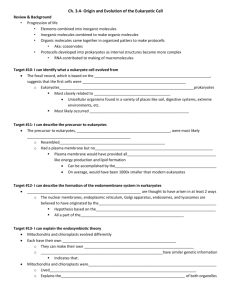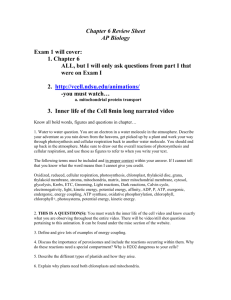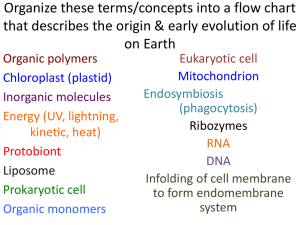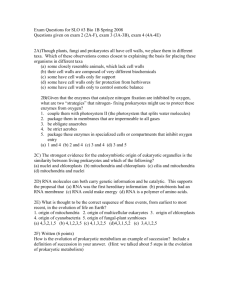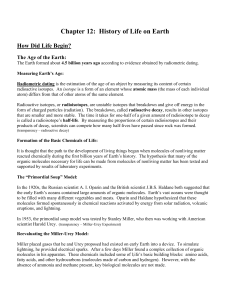Molecular Ecology
advertisement
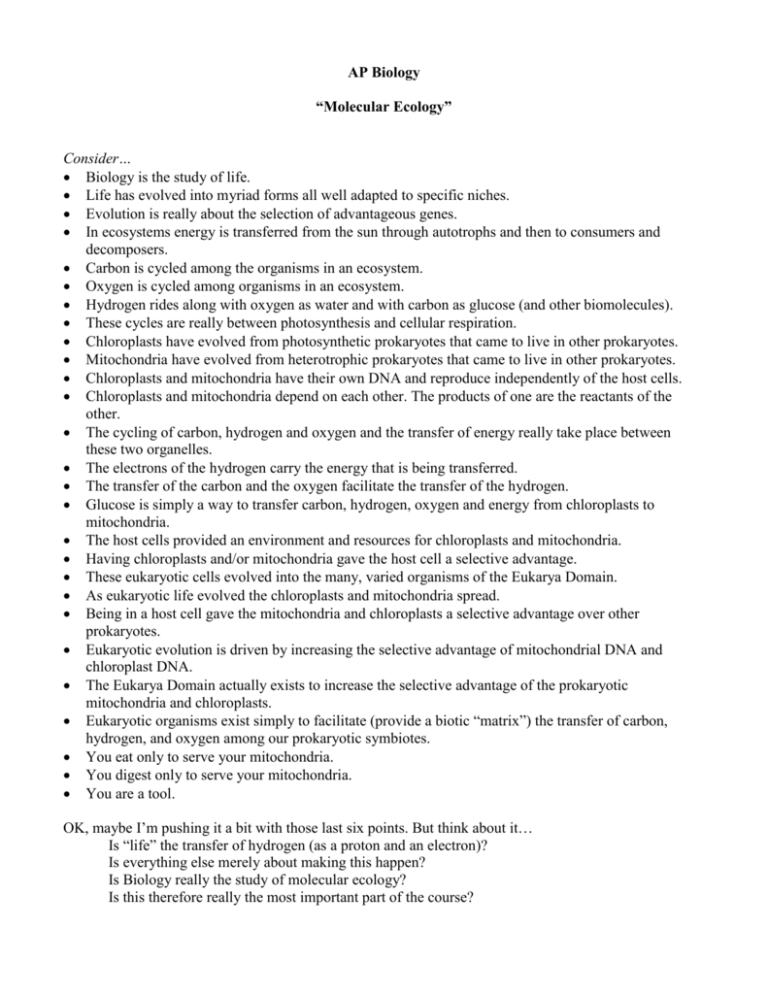
AP Biology “Molecular Ecology” Consider… Biology is the study of life. Life has evolved into myriad forms all well adapted to specific niches. Evolution is really about the selection of advantageous genes. In ecosystems energy is transferred from the sun through autotrophs and then to consumers and decomposers. Carbon is cycled among the organisms in an ecosystem. Oxygen is cycled among organisms in an ecosystem. Hydrogen rides along with oxygen as water and with carbon as glucose (and other biomolecules). These cycles are really between photosynthesis and cellular respiration. Chloroplasts have evolved from photosynthetic prokaryotes that came to live in other prokaryotes. Mitochondria have evolved from heterotrophic prokaryotes that came to live in other prokaryotes. Chloroplasts and mitochondria have their own DNA and reproduce independently of the host cells. Chloroplasts and mitochondria depend on each other. The products of one are the reactants of the other. The cycling of carbon, hydrogen and oxygen and the transfer of energy really take place between these two organelles. The electrons of the hydrogen carry the energy that is being transferred. The transfer of the carbon and the oxygen facilitate the transfer of the hydrogen. Glucose is simply a way to transfer carbon, hydrogen, oxygen and energy from chloroplasts to mitochondria. The host cells provided an environment and resources for chloroplasts and mitochondria. Having chloroplasts and/or mitochondria gave the host cell a selective advantage. These eukaryotic cells evolved into the many, varied organisms of the Eukarya Domain. As eukaryotic life evolved the chloroplasts and mitochondria spread. Being in a host cell gave the mitochondria and chloroplasts a selective advantage over other prokaryotes. Eukaryotic evolution is driven by increasing the selective advantage of mitochondrial DNA and chloroplast DNA. The Eukarya Domain actually exists to increase the selective advantage of the prokaryotic mitochondria and chloroplasts. Eukaryotic organisms exist simply to facilitate (provide a biotic “matrix”) the transfer of carbon, hydrogen, and oxygen among our prokaryotic symbiotes. You eat only to serve your mitochondria. You digest only to serve your mitochondria. You are a tool. OK, maybe I’m pushing it a bit with those last six points. But think about it… Is “life” the transfer of hydrogen (as a proton and an electron)? Is everything else merely about making this happen? Is Biology really the study of molecular ecology? Is this therefore really the most important part of the course? The situation: Imagine you are at Alice’s Mandarin Taste and the little dish of pineapple shows up along with the fortune cookies and the check. You eat some pineapple as you read your fortune. It says, “This pineapple will be eaten and digested, its sugar will be used for energy, it will leave you as gas and water, travel through the atmosphere and eventually it will be used as material for the Aloe plant in your kitchen. Oh, and you will have a big AP Bio project. Lottery Numbers: 7,9,10,37,41,50”. You are surprised at this fortune. How did it know you had an aloe plant? How did it know that you would have an AP Bio project? How did it pick the exact chapters you would need for the AP project as lottery numbers? That night you sit at the kitchen table while your Aunt Mimsy rambles on to your Mother about how no matter how much she has her furnace cleaned and repaired it never reaches 100% efficiency and it should because science has done so much after all we can have vacuum cleaners that move around the room by themselves and burning wood would be more efficient since it all disappears except for the ashes and they don’t weigh as much as the wood did and.... you think about the Aloe plant on the windowsill. How will the pineapple end up in the Aloe? You wonder… Your task: Follow a carbon, hydrogen and oxygen from a glucose molecule from the pineapple through the steps mentioned in the fortune cookie. You are to be as detailed and precise as the material in the text book. You may present this material to me as a narrative, power point presentation, comic book, just about any format other than interpretive dance, though see me to discuss your options. Pay attention to the specifics of the fortune cookie words (including the lottery numbers). Refer to the points made in the Molecular Ecology list (well, maybe not all) We will not spend much time in class on this. Most of this was covered in junior year. I will, however answer any questions you may have. Grading: Despite the way I wrote this, creativity is not important. What will be valued is the: Clear communication of the path the C, H and O will follow from pineapple to Aloe plant. Detailed descriptions of the events along the way. Briefly include carbohydrate digestion Explanations relating structure to function, evolution, ecology and regulation when pertinent. Labeled diagrams to assist your writing. Points: 30% of the 4th term grade (the practice AP exam will be 40%, the case study will be 20%, the biotransformation lab will be 10%) Due Date: April 30, 2012



